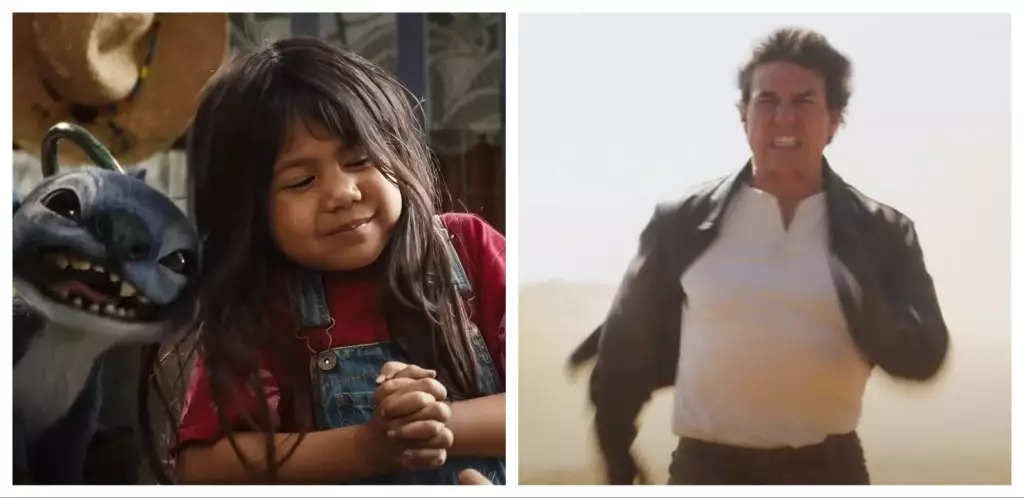In an era where cinematic experiences often struggle to capture the audience’s imagination, recent box office successes like Disney’s “Lilo & Stitch” and Paramount’s “Mission: Impossible 8” have reignited faith in storytelling. Both films are not just dominating the global box office, but they also symbolize the industry’s ability to craft immersive escapism amid ongoing societal challenges. It’s fascinating to observe that these blockbusters, which derive from beloved franchises, are becoming cultural touchstones that resonate with audiences worldwide. As a center-wing liberal, I find it imperative to emphasize that the power of film lies not only in its ability to entertain but also in its capacity to provoke thought and inspire change.
Despite their different narratives and styles, these films reflect distinct facets of the human experience. “Lilo & Stitch,” through its heartwarming themes of family and belonging, has managed to engage viewers across diverse demographics, squeezing out emotions often neglected in modern cinema. On the other hand, “Mission: Impossible 8,” with its high-octane action and morality tale of espionage, serves to entertain while simultaneously addressing themes of loyalty and sacrifice.
The Box Office Metrics: A Deeper Look
The financial metrics surrounding these films underscore their cultural significance. “Lilo & Stitch” has grossed over $610.8 million worldwide, firmly securing its position as a powerhouse in global cinema. The achievement of earning $113.1 million international just last week, with only a 28% decline from the prior weekend, speaks to the film’s enduring appeal. It reflects a blatant refusal by audiences to surrender their attention, proving that the emotional pull of a well-crafted story can sustain high engagement levels.
What’s noteworthy is that the film has emerged as Disney’s second-highest live-action title internationally. This accomplishment is not merely a statistic; it indicates a decisive shift in how audiences are responding to remakes and adaptations. Rather than being tethered to nostalgia in a mere commercial sense, films like this utilize beloved stories to explore modern-day issues, creating a bridge between generations.
Meanwhile, “Mission: Impossible 8,” having raked in $353.8 million globally, demonstrates that action films still hold massive sway. The movie experienced a commendable 33% drop in its second weekend, highlighting that there is a solid fanbase actively seeking out exhilarating narratives. The film’s success, particularly in traditional markets like Japan and the UK, reveals a steadfast loyalty to franchises that manage to evolve while retaining their core elements.
Global Trends and Market Variance
It’s imperative to note how these films have resonated across various geographic locales. They are not only dominating traditional Western markets, but also making significant inroads in emerging territories. For instance, “Lilo & Stitch” performed exceptionally well in Latin America, where it has become the highest-grossing Disney live-action film ever in several countries. This may suggest a cultural resonance tied to themes of family and community, proving that cinema is a global medium shaped by regional narratives.
Conversely, “Mission: Impossible 8” has found unexpected success in China, where audiences have shown a renewed interest in Hollywood blockbusters, evidenced by it becoming the highest-grossing imported film in a single day this year. The globalization of cinema allows for diverse storytelling, but it also raises critical questions about cultural imperialism and local value. It serves as a double-edged sword where the influx of foreign films might overshadow local productions, making the popularity of these blockbusters a twofold phenomenon that merits discussion.
The Challenges Ahead: Balancing Art and Commerce
The landscape of modern cinema is not without its challenges. While audiences flock to these big-budget films, it’s essential to recognize the risks associated with such blockbusters dominating the box office. The dependence on franchise culture can stifle creativity and innovation, replacing original storytelling with regurgitated content.
Moreover, with ticket prices soaring and access to cinema diminishing in some areas, there’s an urgent need for the industry to maintain a balance between profit and originality. How do we ensure that smaller, independent films continue to find their place in a market inundated with high-grossing titles? As someone who aligns with center-wing liberalism, my view is that film should reflect a diverse spectrum of voices and narratives rather than being monopolized by a few franchises.
While the phenomenal success of films like “Lilo & Stitch” and “Mission: Impossible 8” signifies a robust recovery for the cinema industry, it invites a larger conversation about the future of film and its role in society. These narratives have the potential to either unite us or divide us, and how they intertwine with current societal issues remains an urgent topic that deserves our attention.

Leave a Reply